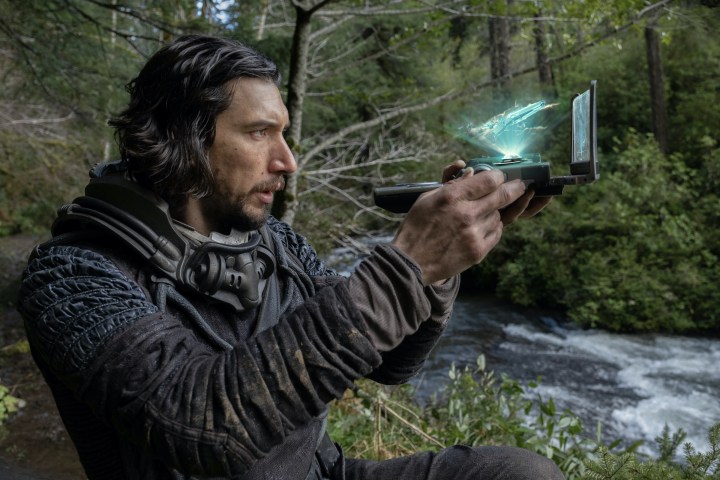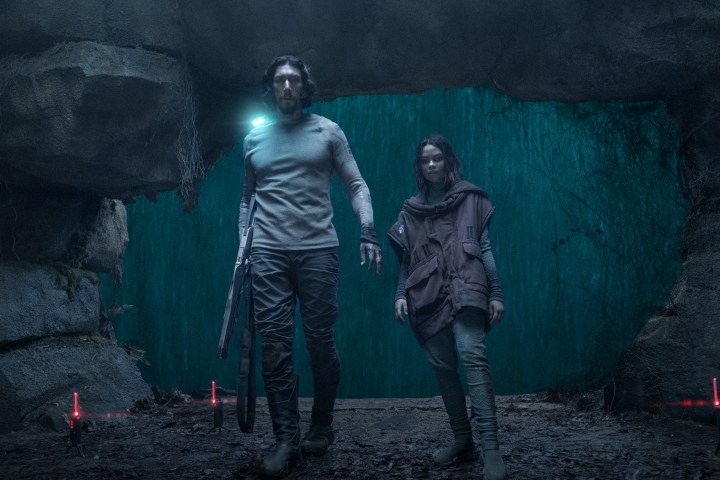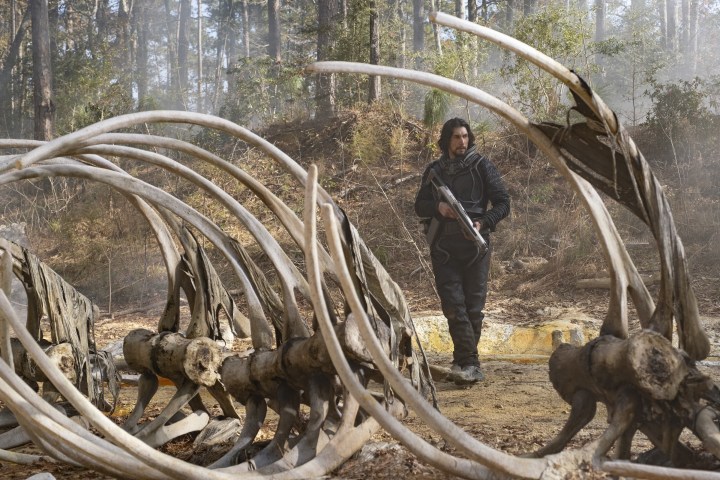
“65 is a simple but effective sci-fi thriller that, thankfully, doesn't overstay its welcome.”
- Adam Driver's committed lead performance
- A lean 93-minute runtime
- Several intense, clever action sequences
- A messy, unpolished visual style
- An overly familiar story
The new movie 65 is a refreshingly unambitious sci-fi blockbuster.
Written and directed by A Quiet Place writers Scott Beck and Bryan Woods, the film is a straightforward, tight thriller that’s interested in little more than forcing its star, Adam Driver, to repeatedly fight a bunch of dinosaurs and other dangerous prehistoric creatures. The film employs no more visual effects than it absolutely needs, and it consistently makes strong use of its real-life environments and locations — most of which prove to be far more dangerous than they initially seem. In case its tight 93-minute runtime didn’t already make this clear: 65 doesn’t have any franchise aspirations, either.
The film’s world-building is concise and efficiently delivered, and Beck and Woods’ screenplay doesn’t ever seem in danger of becoming obsessed with the kind of fictional minutiae or sci-fi gobbledygook that drag down so many other modern blockbusters. Its safeness and limited scope undoubtedly prevent 65 from rising to any truly great heights. However, there’s also something thrilling about the way 65 calls back to the days in which Hollywood’s sci-fi blockbusters could still be self-contained adventures that ask no more of their viewers than 90 minutes of their undivided attention.

As is alluded to by its title, 65 takes place around 65 million years ago and centers on Mills (Driver), a work-for-hire space pilot from a distant, technologically advanced planet. The film’s simple opening scene establishes Mills’ decision to take on a two-year transport mission in order to pay for the expensive medical treatments needed by his sick daughter, Nevine (Chloe Coleman). In its next scene, 65 catches up with Mills’ fateful mission as it’s upended by an asteroid field that damages Mills’ ship and sends him and his passengers crashing onto a nearby, uncharted terrestrial planet.
In the wake of the crash, Mills discovers that all but one of his cryogenically asleep passengers were killed by the destruction of his ship. Mills finds and wakes up the crash’s only other survivor, a young foreign girl named Koa (Ariana Greenblatt), who unfortunately doesn’t speak the same language as Driver’s skilled pilot. Determined to make sure that Koa gets back home safely, Mills takes her on a multiday journey to his ship’s escape vessel, which landed over a dozen kilometers away from where he and Koa ended up.
Along the way, Beck and Woods reveal that Mills hasn’t crash-landed on just any terrestrial planet, but Earth itself. Mills is, therefore, forced throughout his and Koa’s journey to use his scientifically advanced weaponry to fight off a wide range of deadly prehistoric creatures. In what likely won’t come as much of a surprise to anyone who has seen anything even remotely similar to 65, Mills and Koa’s journey also results in the two characters gradually forming an intensely trusting, if unconventional, bond.

Despite what its dramatic opening title reveal would like you to believe, 65 is nowhere near as original as it thinks. Driver’s casting as Mills makes the film’s twist on a typical uncharted planet premise easy to accept, and 65 doesn’t have any more truly subversive tricks hidden up its sleeves. The film spends the bulk of its runtime following Mills and Koa as they encounter a series of dangerous creatures and obstacles over the course of their journey together. The film’s straightforward, obstacle-driven structure results in it feeling a bit repetitive in its second and third acts, which only makes the thinness of 65’s story feel that much more apparent at times.
There is, however, something uncomplicatedly thrilling about watching 65’s heroes come face-to-face with increasingly difficult challenges and still overcome them with their own brute force and intellect. There are moments throughout 65 in which Beck and Woods demonstrate the same knack for action storytelling that they did in A Quiet Place. That’s particularly true of one sequence in which Driver’s Mills is forced to fix his dislocated shoulder before a pack of dangerous, raptor-like dinosaurs get the chance to rip him and Koa apart.
Woods and Beck’s economical approach to 65’s story also allows the pair to make the most out of Mills’ various futuristic weapons. The duo often avoids relying on exposition by simply letting viewers watch Mills put his gadgets to use, as he does during one sequence in which he places a series of glowing markers around his and Koa’s camping spot. The character’s decision to place the markers where he does makes their purpose clear long before their yellow, pulsing lights turn red and Mills begins looking around in fear for any approaching creatures.

Beck and Woods’ visual style isn’t nearly as refined as their storytelling. There are numerous moments throughout 65 when the duo’s uneven mix of general coverage shots and dim lighting makes it difficult to maintain a clear sense of the film’s physical spaces. One underground showdown between Mills and an unidentified dinosaur is particularly confusing to watch due to both the overwhelming darkness throughout it and its lack of establishing wide shots. Beck and Woods bring much more control to some of 65’s other action sequences, but the duo’s visual style nonetheless comes across as disappointingly rough and messy during certain sections of the film.
Fortunately for it, 65 is luckier than most other Hollywood blockbusters because it’s led by Driver, a performer who is willing to bring the same level of commitment to films like 65 as he does to the more grounded dramas he typically stars in. Driver’s performance as Mills is so unsentimental and to the point that it ensures that the character’s rare moments of emotional vulnerability land with real force. In a way, the cut-and-dry nature of Driver’s performance is ultimately a reflection of 65 itself, a film that understands how even the most pared-down version of a story can still be compelling and entertaining if told with enough passion and focus.
65 is now playing in theaters.
Editors' Recommendations
- 5 Oscar-winning sci-fi movies you should watch
- The best sci-fi movies on Hulu right now
- Rosaline review: Kaitlyn Dever lifts up Hulu’s Romeo and Juliet rom-com riff
- Amsterdam review: An exhausting, overlong conspiracy thriller
- Tár review: Cate Blanchett soars in Todd Field’s ambitious new drama



